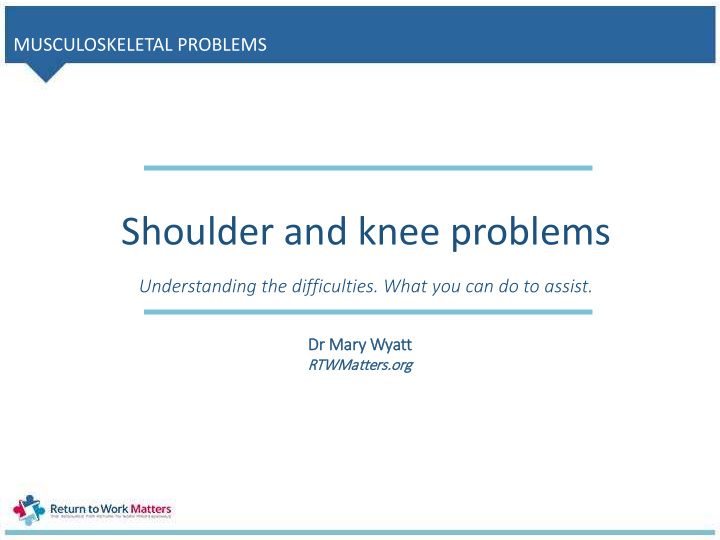



MUSCULOSKELETAL PROBLEMS Shoulder and knee problems Understanding the difficulties. What you can do to assist. Dr Mary W y Wyatt RTWMatters rs.org rg
INTRO Shoulders
Rotator cuff conditions • Most common cause of shoulder pain (60- 70%) • Common in younger people, overhead sports, middle and older age • Many different terms used for this condition – Painful arc – Impingement – Rotator cuff tendinitis – Supraspinatus tendinopathy – Subacromial bursitis – Calcific tendinitis
Contributing factors Wear and tear Repetitive microtrauma Impact on blood supply Narrowing of subacromial space Diabetes
Contributing factors from work • Intrinsic strain: sustained high intramuscular pressure of the rotator cuff muscles impairs the microcirculation, leading to tendonitis and later degeneration • Extrinsic strain: Elevation of the arm may tear or squeeze the subacromial structures between humeral head and the acromion
Work activities that may contribute • Physical work with a heavy load • Awkward postures (working with trunk forward) • Hand above shoulder level There is a dose response relationship – ie the more time on above shoulder height activities the greater the chance of rotator cuff problems
Degeneration Tendinitis Tears 100% 80% 50% 4% 40 60 80 Years Incidence of asymptomatic tears
What happens • 50% better by a year • Often goes away in younger years but might recur • Symptoms often persist in older age groups • A significant number of asymptomatic tears become symptomatic over time (?50% within 5 years)
Treatment • Analgesia, anti-inflammatories • Subacromial steroid injection – dr’s rooms or now most commonly through radiology service • Manual therapy and exercise may improve function and strength • Surgery
Other shoulder disorders • Frozen shoulder (adhesive capsulitis) • Labral tear • Dislocation
Work restrictions • When the elbow is sitting close to the body the shoulder is not generally under load • Lifting the arm away from the body uses the shoulder • Generally for shoulder problems minimising outreaching and above shoulder height helps
Knees
Patellofemoral problems • Tend to occur if the knee is bent for long periods or repeatedly, eg squatting, sitting with knee bent more than 90 degrees • Key aspects of management include • Quad strengthening • Avoid bending the knee
Meniscal or cartilage tear • Tends to be acute and immediately painful • Often with twisting injury • Surgery needed in many cases
Knee osteoarthritis • Common • Weight correlates with increased risk • Typically comes on over time, but can start quickly • Prior injury, eg meniscal or cruciate tear
Treatment for knee OA • Strengthen the quads • Analgesics • Avoid demanding work • Strapping or support bandage • Joint replacement surgery • Controversy about ‘clean up’ arthroscopies
Bursitis • More common with kneeling jobs • Eg housemaids knee • Can drain the fluid if large, but mostly treatment is to avoid activities that contribute to the problem • Antinflammatories can also help
Early care of knee injuries • Support employee to obtain medical care within short time frame • If there is swelling with acute pain then early MRI is sensible • X-ray if thought to be arthritis • Ultrasound if thought to be bursitis
Work restrictions • The knee is loaded while standing, walking and particularly kneeling and squatting • Depending on the condition, sitting at work may give the knee a break • Avoid heavy lifting, stairs, squatting, and maybe walking over uneven ground • Limiting the amount of time standing may help
Questions ❹ Work
Recommend
More recommend